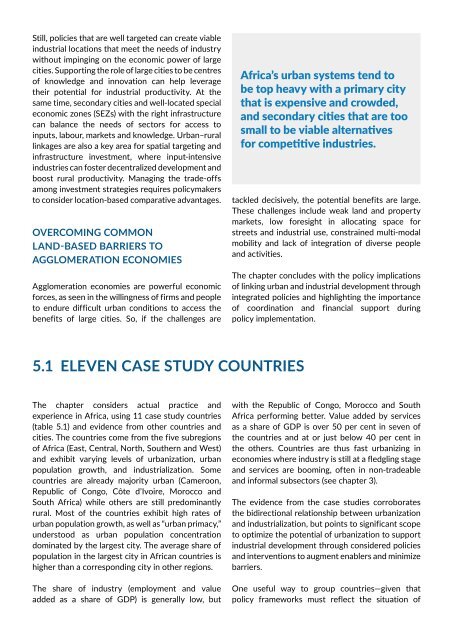URBANIZATION AND INDUSTRIALIZATION
Economic%20Report%20on%20Africa%202017%20UNECA
Economic%20Report%20on%20Africa%202017%20UNECA
You also want an ePaper? Increase the reach of your titles
YUMPU automatically turns print PDFs into web optimized ePapers that Google loves.
Still, policies that are well targeted can create viable<br />
industrial locations that meet the needs of industry<br />
without impinging on the economic power of large<br />
cities. Supporting the role of large cities to be centres<br />
of knowledge and innovation can help leverage<br />
their potential for industrial productivity. At the<br />
same time, secondary cities and well-located special<br />
economic zones (SEZs) with the right infrastructure<br />
can balance the needs of sectors for access to<br />
inputs, labour, markets and knowledge. Urban–rural<br />
linkages are also a key area for spatial targeting and<br />
infrastructure investment, where input-intensive<br />
industries can foster decentralized development and<br />
boost rural productivity. Managing the trade-offs<br />
among investment strategies requires policymakers<br />
to consider location-based comparative advantages.<br />
OVERCOMING COMMON<br />
L<strong>AND</strong>-BASED BARRIERS TO<br />
AGGLOMERATION ECONOMIES<br />
Agglomeration economies are powerful economic<br />
forces, as seen in the willingness of firms and people<br />
to endure difficult urban conditions to access the<br />
benefits of large cities. So, if the challenges are<br />
Africa’s urban systems tend to<br />
be top heavy with a primary city<br />
that is expensive and crowded,<br />
and secondary cities that are too<br />
small to be viable alternatives<br />
for competitive industries.<br />
tackled decisively, the potential benefits are large.<br />
These challenges include weak land and property<br />
markets, low foresight in allocating space for<br />
streets and industrial use, constrained multi-modal<br />
mobility and lack of integration of diverse people<br />
and activities.<br />
The chapter concludes with the policy implications<br />
of linking urban and industrial development through<br />
integrated policies and highlighting the importance<br />
of coordination and financial support during<br />
policy implementation.<br />
5.1 ELEVEN CASE STUDY COUNTRIES<br />
The chapter considers actual practice and<br />
experience in Africa, using 11 case study countries<br />
(table 5.1) and evidence from other countries and<br />
cities. The countries come from the five subregions<br />
of Africa (East, Central, North, Southern and West)<br />
and exhibit varying levels of urbanization, urban<br />
population growth, and industrialization. Some<br />
countries are already majority urban (Cameroon,<br />
Republic of Congo, Côte d’Ivoire, Morocco and<br />
South Africa) while others are still predominantly<br />
rural. Most of the countries exhibit high rates of<br />
urban population growth, as well as “urban primacy,”<br />
understood as urban population concentration<br />
dominated by the largest city. The average share of<br />
population in the largest city in African countries is<br />
higher than a corresponding city in other regions.<br />
The share of industry (employment and value<br />
added as a share of GDP) is generally low, but<br />
with the Republic of Congo, Morocco and South<br />
Africa performing better. Value added by services<br />
as a share of GDP is over 50 per cent in seven of<br />
the countries and at or just below 40 per cent in<br />
the others. Countries are thus fast urbanizing in<br />
economies where industry is still at a fledgling stage<br />
and services are booming, often in non-tradeable<br />
and informal subsectors (see chapter 3).<br />
The evidence from the case studies corroborates<br />
the bidirectional relationship between urbanization<br />
and industrialization, but points to significant scope<br />
to optimize the potential of urbanization to support<br />
industrial development through considered policies<br />
and interventions to augment enablers and minimize<br />
barriers.<br />
One useful way to group countries—given that<br />
policy frameworks must reflect the situation of


